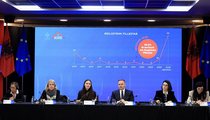The health paradox of the EU: Shortage in the number of staff and increase in doctors and nurses!

The European healthcare sector faces a real paradox in 2024: while the WHO estimates that by 2030 staff shortages will reach four million professionals, the number of doctors and nurses has never been higher. Over the last two decades, the number of doctors and nurses per capita has increased significantly in most EU countries. In 2022, more than one in ten jobs were on average in the health and social care sectors across EU countries, up from 8.5% in 2002.
But demographics are making the outlook worse. An aging population and workforce will increase the demand for healthcare professionals, while staff shortages will put further pressure on the system. According to OECD estimates, by 2050, there will be 38 million more people aged over 65 and 26 million fewer people of working age. This means more people with higher needs, fewer people of working age.
At the same time, interest in health careers among young people is declining, the OECD warned, and healthcare professionals across the EU are taking to the streets to demand better pay and working conditions. The ongoing protests and demands by healthcare professionals highlight the critical challenges they face, including insufficient pay and inadequate working conditions.
Low wages, political and economic instability and poor working conditions nationally are driving healthcare workers out of the sector or to seek opportunities abroad. As a result, European countries are relying on foreign-trained health professionals to fill domestic gaps, a solution that could exacerbate staff shortages in home countries.
The health workforce is also ageing: by 2022, more than a third of doctors in all EU countries will be over 55, with this proportion reaching 40% or more in almost half of the EU countries. The decision by many doctors to continue working beyond the standard retirement age has helped prevent a worsening of staff shortages in many EU countries over the past decade, the OECD report shows.
This presents a double challenge for the countries concerned, as they will need to train enough new doctors to replace those who retire and, at the same time, implement policies to encourage current doctors to stay on to work beyond the standard retirement age. Reduced working hours will be a factor in attracting new recruits. European countries had an estimated shortage of around 1.2 million doctors, nurses and midwives in 2022, according to the joint report by the OECD and the European Commission.
But will more doctors be the only solution? The OECD concluded that no. "Against this background, the EU has a crucial role to play in supporting member states in their efforts to attract, train and retain a sufficient number of qualified and motivated health workers," the OECD report said. Consequently, EU health policy is increasingly moving from reaction to prevention, with the 'Beat Cancer' plan the mainstay of the last mandate and a new plan on cardiovascular disease in preparation for the EU Council. The report identifies two areas of work for innovation: a change in the organization of work and the introduction of new technologies.
Segregation of duties was widely discussed during the COVID-19 pandemic, when roles traditionally performed by doctors had to be outsourced due to high demand, such as vaccination, which was then carried out in pharmacies. On the other hand, the use of digital tools and AI is growing in this sector, as innovations are becoming essential to increase the productivity of healthcare workers and allow them to focus more on patient care.

1X introduces the humanoid robot NEO - The new device will help people in doing household chores
The race to be the first humanoid robot to welcome into our homes continues, with big companies like Tesla and small startups competing to make this......

Holidays increase hotel prices in Korça - The cost of accommodation reaches 33% more on New Year's Eve
As we slowly approach the end of the year holidays, more and more hotels, mainly those located in the colder areas of the country, are increasing their......

Tourism and wages "powered" consumption in the country - 10-month, domestic VAT revenues exceeded 88 million euros
Consumption throughout the year 2024 has played a very important role in the positive performance of the economy. The many tourists who have visited Albania,......

Global debt tops USD 320 trillion - Budget deficits and trade tensions could cause further growth
The stock of global debt rose by more than $12 trillion in the first three quarters of 2024, reaching a new record of nearly $323 trillion, a report from a......

Sustainable hunting and wildlife conservation - Changes to the law about to happen. What are the goals to be achieved?
The Draft Law "On Hunting" has been published for Public Consultation where its drafting improves the current law in some of its specific articles. The new......

How can we furnish the house without much cost? - During this year, about 11 billion ALL of furniture was imported
Home furnishing, more than aesthetic and functional, is a choice that also shows the lifestyle of a family. In the show Economy 3D, it was discussed how much......

US Tariffs on Southeast Asian Countries - Target Solar Panel Imports to Protect Domestic Production
The US Commerce Department has imposed preliminary tariffs on solar panel imports from four Southeast Asian countries. The new round of tariffs aims to......

196 km of railway line rehabilitated by 2030 - WBIF report/ Investments to increase the capacity of power transmission lines
By 2030, 196 kilometers of railway lines are expected to be rehabilitated in Albania. The European Union intends that through the Western Balkans Investment......





















